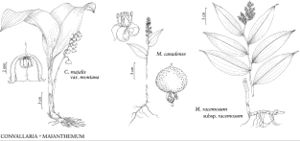Maianthemum
Prim. Fl. Holsat., 14. 1780.
| Taxon | Illustrator ⠉ | |
|---|---|---|
 | Convallaria majalis var. montana Maianthemum canadense Maianthemum racemosum subsp. racemosum | Yevonn Wilson-Ramsey Yevonn Wilson-Ramsey Yevonn Wilson-Ramsey |
Herbs, perennial, terrestrial or aquatic, 1–12.5 dm, from rhizomes. Rhizomes persistent, sympodial, spreading and filiform, or densely clumped, cylindrical, and fleshy. Stems simple, arching or erect. Leaves 2–15, cauline, distichous, clasping or short-petiolate; blade usually ovate, glabrous or weakly pubescent, base rounded or cordiform, margins flat or undulate, denticulate or entire, apex acute or caudate. Inflorescences terminally paniculate or racemose, 5–250-flowered. Flowers 3-merous (6 tepals, 6 stamens) or, by reduction, 2-merous (4 tepals, 4 stamens); perianth spreading; tepals distinct, white, ovate or triangular, equal, 0.5–5 mm; stamens inserted at tepal base; anthers 4-locular, dehiscence introrse; ovary superior, 2–3-carpellate, septal walls with nectariferous canals; style shorter than 1.5 mm; stigma 2–3-lobed, less than 1 mm wide; pedicel subtended by 1 or more bracts. Fruits baccate, variously mottled when immature, bright red at maturity, usually lobed, 4–12 mm wide, pulp thin. Seeds 1–12, globose, 3–6 mm diam.; testa pale-brown, thin; endosperm scaly. x = 18.
Distribution
North America, Central America, n Europe, e Asia to the Himalayas
Discussion
Species 30 (5 in the flora).
Outside the flora area, Maianthemum may be epiphytic, with foliage stems pendent or erect; two species are dioecious; tepals may be fused, the perianth campanulate; and tepals and anthers may be pink, green, or violet.
The two species of Maianthemum that bear 4-tepaled flowers, M. canadense and M. dilatatum, are very similar to one another and to the boreal Eurasian species M. bifolium (Linnaeus) F. W. Schmidt, and the three have sometimes been considered varieties of a single species. In most recent floristic works, the genus Maianthemum has been limited to these three species because of their reduced flowers, whereas the remaining species, which bear 6-tepaled flowers more typical of the Liliaceae, have been placed in the genus Smilacina. J. V. LaFrankie (1986) placed all the species in a single genus.
The monophyly of Maianthemum sensu lato is supported by morphological consistencies including baccate fruits that are marked when immature, a consistent and unique karyotype (S. Kawano and H. H. Iltis 1966; S. Kawano et al. 1967; N. H. Valentine and H. M. Hassan 1971; M. N. Tamura 1995), and molecular analysis (P. J. Rudall et al. 2000; J. Yamashita and M. N. Tamura 2000). The 2-merous floral condition in Maianthemum sensu stricto is the result of anatomical reduction from the 3-merous state (F. H. Utech and S. Kawano 1976).
Selected References
None.
Lower Taxa
Key
| 1 | Rhizomes 8–14 mm wide; inflorescences paniculate, branches well developed; tepals inconspicuous, 0.5–1 mm. | Maianthemum racemosum |
| 1 | Rhizomes 1–4.5 mm wide; inflorescences racemose, simple or complex, flowers 1–4 per node; tepals conspicuous, longer than 1 mm. | > 2 |
| 2 | Rhizomes 15–60 cm × 3–4.5 mm, roots scattered; leaves 8–11 on fertile shoots; tepals 6; immature fruits green striped with black. | Maianthemum stellatum |
| 2 | Rhizomes 1–30 cm × 1–2 mm, roots restricted to nodes; leaves 2–4 on fertile shoots; tepals 4 or 6; immature fruits green mottled or spotted with red. | > 3 |
| 3 | Leaf blade base tapered; racemes simple; tepals 6. | Maianthemum trifolium |
| 3 | Leaf blade base with narrow or broad sinus; racemes complex, with 1–4 flowers per node; tepals 4. | > 4 |
| 4 | Plants 10–25 cm; proximal leaves sessile, blade ovate, base with narrow sinus; distal leaf blade cordate; petiole 1–7 mm; flowers (1–)2(–3) per node. | Maianthemum canadense |
| 4 | Plants 20–45 cm; proximal leaves short-petiolate, blade triangular to cordate, base with broad, open sinus; distal leaf blade deeply cordate; petiole 7–10 cm; flowers (1–)3(–4) per node. | Maianthemum dilatatum |
"broad" is not a number."thicker" is not a number.